We've reached the period where the Chemise gown comes in. Though this is by no means a universally taken up style, you can see the echos of gauze, sashes, and collared necklines in other gowns. Large hats, hair, bums, and bosoms are ripe with comedic possibilities if one takes it too far.
Front
Closure: Closed front most common, some use lacing for closure
Neckline: Very low and open, rounded
Skirt opening: Over 8", almost to sides in some cases, Round gowns coming into vogue
Waistline: Pointed, squared, flat, and curved
Back
Style: English backs and Quarter backs very common
Pleats: Very narrow, some inverted for even smaller look on English backs.
Skirt Pleats: Often less than 1/4", some with cartridge pleats
Shoulder Span: Sleeve corner very high and narrow
Sleeves
Long sleeves in two-part and Elbow length in one-part.
Trim
Sleeves: Most have little or no trim, some with large gathered gauze cuffs
Style: Ribbon, narrow fabric, some contrast fabrics flat with trim edges
Edges: Rolled hem, trimmed, or some pinking
Content: Gauze, self-fabric, and contrast all common
Fabric
Stripes, solid, and some small prints or brocades. Cotton chintz prints and cotton sheers popular.
Shape
V&A Cotton Print Gown, 1785
Met Silk Stripe Gown, 1785-90
LACMA Printed Cotton Gown, late 1780s
LACMA Silk Stripe Gown, 1785
KCI Painted Silk Gown, 1785
Vaux-hall, 1785
Thames Waterman, 1785
The Lady of the Manor, 1786
The Love Letter, 1787
Reflection, 1787
The Rival Favourites, 1788
Restoration Dresses, 1789



















No comments:
Post a Comment